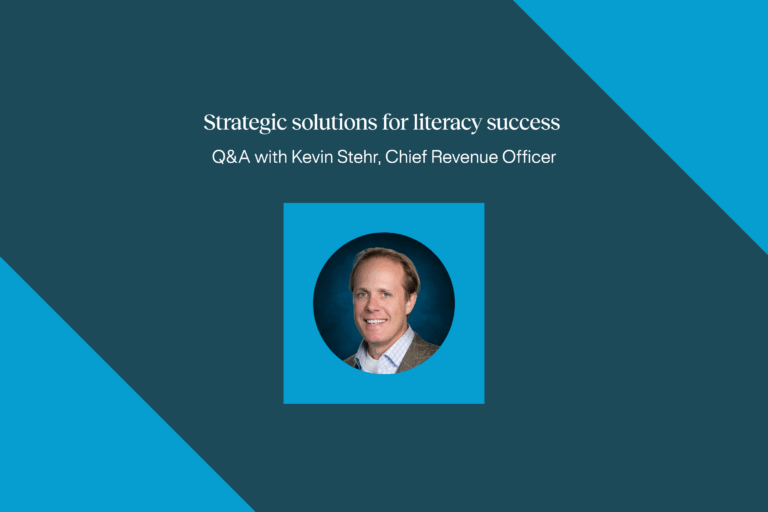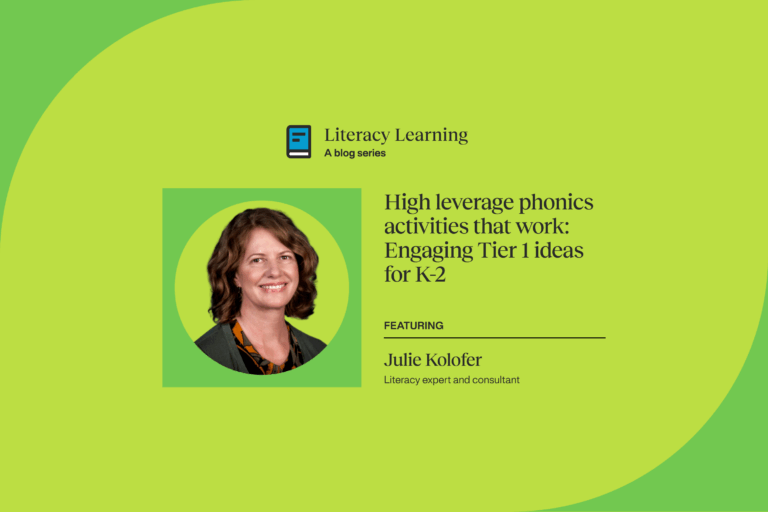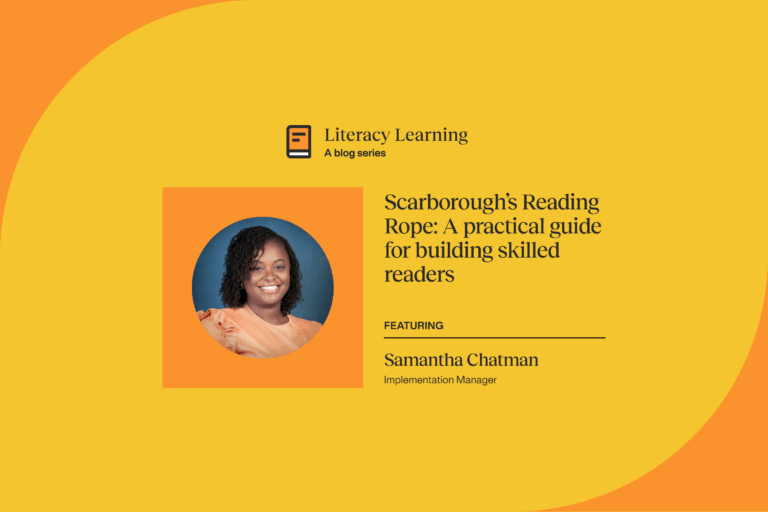Get students reading at grade level

When it comes to literacy instruction, an evidence-based curriculum and best practices matter
A few years ago, we often heard from educators that they were adapting 95 Percent Group’s intervention products for their Tier 1 instruction. Teachers are experts in making the most out of the resources they have. But 95 Percent Group listened to them and understood this as an important call to action. In 2020, 95 Phonics Core Program® launched to help teachers serve all of their students better and specifically meet the needs of Tier 1 phonics instruction.
“About 80 to 85% of the class needs to be taught well in the core program, which leaves fewer kids for intervention in Tiers 2 and 3,” said Laura Stewart, Chief Academic Officer for 95 Percent Group.
95 Percent Group also added a complementary technology tool to the program—digital and interactive HTML files—to enhance the whole-class experience and also support remote and hybrid experiences. Today these digital files are saving teachers time, promoting student engagement, and ensuring consistent, high-quality instruction across classrooms and schools.
The combination of 95 Percent Group’s knowledge in the science of reading and in the science of learning creates significant opportunities for educators and students. As you evaluate and make important decisions about the instructional materials in your school or district’s literacy toolkit, make sure academic excellence is your top priority. Keep this in mind: Research alignment is not enough. Your literacy programs should be evidence-based and evidence-proven to accelerate literacy skills. Here is what the evidence says about how to teach children to read at grade level and how to bring it into practice in your school and classroom.
Provide explicit, direct instruction
One key design element of the 95 Phonics Core Program is its approach to explicit and direct instruction of phonics that forms the basis of the 95 Percent Group product offering. Study after study proves the same thing: explicit and systematic phonics instruction is more effective than unsystematic or no phonics instruction, especially with at-risk readers. According to the National Reading Panel, first-grade students who were taught systematic phonics instruction were better at decoding and spelling and, therefore, better able to comprehend texts (2001). With the 95 Phonics Core Program, students are being taught the right content at the right time. Students in Kindergarten to 3rd grade acquire essential foundational skills such as phonemic awareness, decoding, and word/passage reading fluency. The Core Program provides students with ample practice opportunities that reinforce the explicit teaching of phonics patterns:
- By using manipulatives (colored chips)
- By using gestures for the syllable types
- By reinforcing learning with the reading-writing connection through word chaining, writing words in sound boxes, and writing sentences from dictation
- Sound spelling identification through mapping and dictation of high-frequency words
Deploy multimodal learning
95 Phonics Core Program was designed with diverse learners in mind. Because it is a Tier 1 curriculum, it incorporates multisensory learning into the lessons by using gestures and manipulatives. Making education multisensory helps deeper learning, benefiting students most in need. For example, students with dyslexia need more opportunities to develop “adequate and automatic integration of letters and speech sounds” (Blomert & Froyen, 2010). In the curriculum, multiple senses reinforce concepts. With the help of 95 Phonics Chip Kits, teachers gain the tools and strategies to explain phonics patterns, which allows scholars to visualize abstract concepts and makes their learning more concrete. Using hands-on phonics chip movements advances phonemic awareness to an automatic level. Students move the colored chips into sound boxes to represent words the teacher dictates; after mapping the sounds in a word, students write the letters in the appropriate sound boxes in the Student Workbook. Throughout each lesson, students are expected to respond during whole-class instruction through call and response to increase phonemic awareness and use gestures (V-shape, closed fist, open fist, etc.) for syllable types.
Support guided practice
95 Percent Group employs guided practice through Gradual Release of Responsibility (GRR), first introduced by Pearson and Gallagher to provide differentiated instruction for all students. The purpose of Gradual Release is to slowly pull away scaffolds in a way that makes all students feel successful. Each lesson begins with a teacher-led activity where students are expected to engage in a series of verbal repetitions to increase their phonemic awareness (National Reading Panel, 2000). Educators then transition with an explicit think-aloud of skill as the “I Do” portion of the phonics instruction. During this lesson phase, the educator facilitates a mediated opportunity for students to practice the new skill. Finally students are released independently to practice with manipulatives and are given several at-bats. Through the gradual release model’s continuous teacher-student interaction, teachers can differentiate and scaffold as necessary. This allows teachers to spend as much—or as little—time as necessary on a given skill. The ‘We Do’ and ‘You Do’ phase allows educators to provide valuable, instant feedback to students (Rosenshine, 2012). Moving students forward as quickly as possible, but as slowly as necessary, is key to effective intervention instruction.
Nurture interactive learning
95 Percent Group has also made a deep investment in research both to inform the development of its offerings and to demonstrate their efficacy to educators around the country. The curriculum comes with research-based routines and digital, HTML files to ensure the highest quality of instruction. Digital files may seem simple, but their impact is huge. When the science of reading, science of learning, and technology intersect, they create a unique experience that provides limitless opportunities for educators and students within the classroom. With interactive files that keep educators and students on pace during their lessons and with student-centered activities that require a response from each student (call and response, gestures, manipulatives), learning outcomes are higher than in classrooms that do not engage in interactive learning strategies (Javed & Odhabi, 2018). This technology holds students and educators accountable to staying on pace and delivering succinct instruction with consistent terminology and routines.
Phonics should no longer be taught through a “drill and kill” learning environment. Perky-paced routines give students a number of opportunities for deep learning. And the results say it all. Regardless of geographic location, duration of time, or stand-alone vs. group intervention, 95 Phonics Core Program has garnered positive growth on post-assessments. But 95 Phonics Core Program is the starting point for nurturing an interactive learning environment. 95 Percent Group continues to build a community of trust and learning alongside educators who desire to grow their knowledge of the science of reading and improve instructional practices together.
Learn more
95 Percent Group regularly sponsors third-party research by independent literacy evaluation firms to measure the effectiveness of their programs. Learn more and download the efficacy studies.
References
Blomert, L., & Froyen, D. (2010). Multi-sensory learning and learning to read. International journal of psychophysiology, 77(3), 195-204.
Ehri, L. C., Nunes, S. R., Stahl, S. A., & Willows, D. M. (2001). Systematic phonics instruction helps students learn to read: Evidence from the National Reading Panel’s meta-analysis. Review of Educational Research, 71(3), 393–447. https://doi.org/10.3102/00346543071003393
Foorman, B. R., Francis, D. J., Fletcher, J. M., Schatschneider, C., & Mehta, P. (1998). The role of instruction in learning to read: Preventing reading failure in at-risk children. Journal of educational Psychology, 90(1), 37.
Javed, Y. & Odhabi, H. “Active Learning in Classrooms Using online Tools: Evaluating Pear-Deck for Students’ Engagement,” 2018 Fifth HCT Information Technology Trends (ITT), 2018, pp. 126-131, doi: 10.1109/CTIT.2018.8649515.
National Reading Panel (U.S.) & National Institute of Child Health and Human Development (U.S.). (2000). Report of the National Reading Panel: Teaching children to read : an evidence-based assessment of the scientific research literature on reading and its implications for reading instruction. U.S. Dept. of Health and Human Services, Public Health Service, National Institutes of Health, National Institute of Child Health and Human Development.
Rosenshine, B. (2012). Principles of instruction: Research-based strategies that all teachers should know. American Educator, 36(1), 12.



